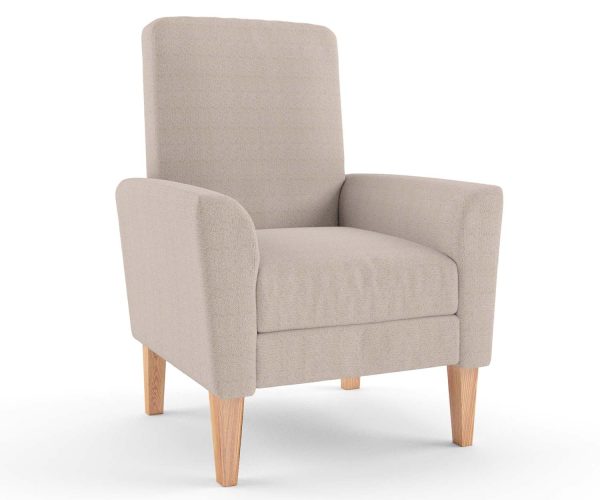Your Furniture Might be Toxic: Why You Should Beware of PFAS in Furniture

In furniture for aged care, retirement living, and hospitality, ensuring the safety and comfort of your residents, guests and staff is paramount. When it comes to aged care furniture, ensuring the safety of an organization’s service environment also falls under Standard 5 of the Aged Care Quality Standards outlined by the Aged Care Quality and Safety Commission. One often overlooked hazard that could compromise health and well-being is the presence of PFAS in furniture. With a focus on Australian made furniture, we’ll delve into what PFAS is, why it’s dangerous to health, and why it’s essential to ask your furniture manufacturer about it.
Unmasking Furniture Peril: What is PFAS?
PFAS, short for Per- and Polyfluoroalkyl Substances, encompasses a group of man-made chemicals that provide products with the ability to resist heat, water, and oil. These compounds have been widely used in various applications, including furniture manufacturing. While their unique properties are advantageous for many industries, the dark side of PFAS chemicals is a matter of growing concern.
What Products Contain PFAS Chemicals in Furniture Manufacturing?
PFAS chemicals find their way into a variety of products, and furniture manufacturing is no exception. In this industry, PFAS are often used in materials that require resistance to stains, water, and wear. For instance, stain-resistant fabrics, such as those used for upholstery and cushions, frequently contain PFAS. Water-repellent coatings on furniture, like those applied to wooden surfaces, are another common application. PFAS can also be present in the foam used for cushioning and the adhesives that hold furniture components together. Understanding the potential sources of PFAS in furniture production is essential for making informed choices and ensuring the safety of the end-users, whether in healthcare, hospitality, or everyday living.
The Health Hazards: Why You Should Be Cautious of PFAS Chemicals
PFAS chemicals have been associated with a range of health issues, making them a potential hidden hazard in your furniture:
- Cancer Risk: Studies have linked exposure to certain PFAS compounds with an increased risk of cancer, including kidney and testicular cancers.
- Immune System Effects: PFAS exposure can weaken the immune system, making individuals more susceptible to infections and diseases.
- Developmental Delays: Children exposed to PFAS may experience developmental delays, impacting their physical and mental growth.
- Reproductive Issues: There is evidence suggesting that PFAS exposure can affect fertility and pregnancy outcomes.
- Liver Damage: Some PFAS chemicals have been associated with liver toxicity. PFOA, for example, has been shown to accumulate in the liver and can lead to liver damage, potentially causing severe health issues over time.
- Thyroid Disorders: There is evidence to suggest that PFAS exposure can disrupt thyroid hormone function, leading to thyroid disorders. The thyroid plays a crucial role in regulating metabolism and overall health, so any disturbances in its function can have widespread health implications.
- High Cholesterol: Long-term exposure to PFAS has been associated with elevated levels of cholesterol in the bloodstream, which is a risk factor for heart disease. High cholesterol can contribute to the development of atherosclerosis and cardiovascular issues.
- Hormone Disruption: Some PFAS compounds have been found to interfere with hormone regulation in the body. This can lead to a range of health issues related to the endocrine system, including disruptions in reproductive, metabolic, and immune functions.
Fast Furniture, Hidden Danger
Many low-quality, “fast furniture” options that are often inexpensive and not designed to last may contain PFAS. These products are made with cost-cutting in mind, and as a result, they may incorporate cheaper materials that contain harmful chemicals like PFAS. This is why it’s crucial to invest in furniture from trusted Australian manufacturers who prioritize quality and safety.
The Importance of Dialogue: Talk to Your Australian Furniture Manufacturer
Engaging in a conversation with your Australian furniture manufacturer is crucial. Ask them about their use of PFAS in their products and whether they have taken steps to eliminate these harmful substances. Reputable manufacturers have been making significant strides in this regard.
Crypton Fabrics: A Safer Choice
One significant step in ensuring the safety of your furniture is choosing PFAS-free materials. For example, Crypton fabrics, have been PFAS-free since 2022. Crypton is a brand known for its high-performance, stain-resistant, and durable fabrics, and they have eliminated PFAS from their products. Many people choose Crypton fabrics precisely because they offer stain resistance without the use of PFAS, addressing health and environmental concerns associated with these chemicals. However, it’s always a good practice to verify with the manufacturer or the specific product to ensure that it is indeed PFAS-free, as formulations and manufacturing processes can vary.
Environmental Impact: Beyond Health
Beyond the health concerns, it’s important to consider the environmental impact of PFAS. These chemicals are notorious for their persistence in the environment and resistance to degradation. This persistence can lead to long-term contamination of soil, water, and ecosystems.
In conclusion, your choice of furniture can have a profound impact on the well-being of your residents or guests. PFAS in furniture is a hidden hazard that should not be taken lightly. By investing in Australian-made furniture from trusted manufacturers and opting for PFAS-free materials like Crypton fabrics, you can ensure a safer and healthier living or hospitality environment. The health and comfort of those you care for and serve should always be a top priority.
FAQs About PFAS Chemicals
What are PFAS chemicals?
PFAS stands for per- and polyfluoroalkyl substances. These are a group of synthetic chemicals used in a variety of industrial applications and consumer products due to their water- and grease-resistant properties.
Where are PFAS chemicals commonly found?
PFAS chemicals are found in a wide range of products, including firefighting foams, non-stick cookware, waterproof clothing, food packaging, and some cleaning products. They have also been detected in the environment, particularly in water sources near industrial sites and military bases.
Why are PFAS chemicals a concern?
PFAS chemicals are a concern due to their persistence in the environment, bioaccumulation in living organisms, and potential adverse health effects. Exposure to high levels of PFAS has been linked to various health issues, including developmental problems, liver damage, and certain cancers.
How do people come into contact with PFAS chemicals?
People can come into contact with PFAS through contaminated water sources, consumption of contaminated food, and exposure to products that contain PFAS. Individuals working in industries where PFAS is used, such as firefighting, may face higher exposure risks.
What are the health effects associated with PFAS exposure?
Health effects of PFAS exposure may include thyroid dysfunction, decreased fertility, developmental delays in children, and an increased risk of certain cancers. However, the exact health impact can vary based on the specific PFAS compound and the level of exposure.
How do PFAS chemicals enter the environment?
PFAS chemicals can enter the environment through industrial discharges, the use of PFAS-containing products, and the release of firefighting foam. Once in the environment, PFAS can persist for a long time and accumulate in soil, water, and wildlife.
Are there regulations governing PFAS use and exposure?
Many countries, have established regulations or guidelines for PFAS in drinking water and some consumer products. Efforts are ongoing to assess and regulate the use of PFAS due to their environmental and health concerns.
How can individuals reduce their exposure to PFAS?
Individuals can reduce their exposure to PFAS by avoiding products with PFAS, using alternatives to non-stick cookware, and being cautious about potential sources of contaminated water. It’s also essential to stay informed about local water quality and follow any guidance provided by health authorities.
How are PFAS chemicals treated or removed from water sources?
Treatment methods for PFAS in water include activated carbon filtration, ion exchange, and reverse osmosis. However, complete removal of PFAS from water can be challenging, and ongoing research is focused on developing more effective treatment technologies.
Is there ongoing research on PFAS and its impact on health and the environment?
Yes, there is ongoing research to better understand the health effects of PFAS exposure, develop more accurate detection methods, and explore remediation strategies. Scientists and regulatory agencies continue to monitor and assess the impact of PFAS on both human health and the environment.
Australian Made Furniture that Follows the Australian National Aged Care Design Principles and Guidelines
Aged care chairs should be both supportive (Guideline 1.9 – Supportive Seating) and appropriate (Guideline 2.8 – Appropriate Furniture).
More News
Your Furniture Might be Toxic: Why You Should Beware of PFAS in Furniture

In furniture for aged care, retirement living, and hospitality, ensuring the safety and comfort of your residents, guests and staff is paramount. When it comes to aged care furniture, ensuring the safety of an organization’s service environment also falls under Standard 5 of the Aged Care Quality Standards outlined by the Aged Care Quality and Safety Commission. One often overlooked hazard that could compromise health and well-being is the presence of PFAS in furniture. With a focus on Australian made furniture, we’ll delve into what PFAS is, why it’s dangerous to health, and why it’s essential to ask your furniture manufacturer about it.
Unmasking Furniture Peril: What is PFAS?
PFAS, short for Per- and Polyfluoroalkyl Substances, encompasses a group of man-made chemicals that provide products with the ability to resist heat, water, and oil. These compounds have been widely used in various applications, including furniture manufacturing. While their unique properties are advantageous for many industries, the dark side of PFAS chemicals is a matter of growing concern.
What Products Contain PFAS Chemicals in Furniture Manufacturing?
PFAS chemicals find their way into a variety of products, and furniture manufacturing is no exception. In this industry, PFAS are often used in materials that require resistance to stains, water, and wear. For instance, stain-resistant fabrics, such as those used for upholstery and cushions, frequently contain PFAS. Water-repellent coatings on furniture, like those applied to wooden surfaces, are another common application. PFAS can also be present in the foam used for cushioning and the adhesives that hold furniture components together. Understanding the potential sources of PFAS in furniture production is essential for making informed choices and ensuring the safety of the end-users, whether in healthcare, hospitality, or everyday living.
The Health Hazards: Why You Should Be Cautious of PFAS Chemicals
PFAS chemicals have been associated with a range of health issues, making them a potential hidden hazard in your furniture:
- Cancer Risk: Studies have linked exposure to certain PFAS compounds with an increased risk of cancer, including kidney and testicular cancers.
- Immune System Effects: PFAS exposure can weaken the immune system, making individuals more susceptible to infections and diseases.
- Developmental Delays: Children exposed to PFAS may experience developmental delays, impacting their physical and mental growth.
- Reproductive Issues: There is evidence suggesting that PFAS exposure can affect fertility and pregnancy outcomes.
- Liver Damage: Some PFAS chemicals have been associated with liver toxicity. PFOA, for example, has been shown to accumulate in the liver and can lead to liver damage, potentially causing severe health issues over time.
- Thyroid Disorders: There is evidence to suggest that PFAS exposure can disrupt thyroid hormone function, leading to thyroid disorders. The thyroid plays a crucial role in regulating metabolism and overall health, so any disturbances in its function can have widespread health implications.
- High Cholesterol: Long-term exposure to PFAS has been associated with elevated levels of cholesterol in the bloodstream, which is a risk factor for heart disease. High cholesterol can contribute to the development of atherosclerosis and cardiovascular issues.
- Hormone Disruption: Some PFAS compounds have been found to interfere with hormone regulation in the body. This can lead to a range of health issues related to the endocrine system, including disruptions in reproductive, metabolic, and immune functions.
Fast Furniture, Hidden Danger
Many low-quality, “fast furniture” options that are often inexpensive and not designed to last may contain PFAS. These products are made with cost-cutting in mind, and as a result, they may incorporate cheaper materials that contain harmful chemicals like PFAS. This is why it’s crucial to invest in furniture from trusted Australian manufacturers who prioritize quality and safety.
The Importance of Dialogue: Talk to Your Australian Furniture Manufacturer
Engaging in a conversation with your Australian furniture manufacturer is crucial. Ask them about their use of PFAS in their products and whether they have taken steps to eliminate these harmful substances. Reputable manufacturers have been making significant strides in this regard.
Crypton Fabrics: A Safer Choice
One significant step in ensuring the safety of your furniture is choosing PFAS-free materials. For example, Crypton fabrics, have been PFAS-free since 2022. Crypton is a brand known for its high-performance, stain-resistant, and durable fabrics, and they have eliminated PFAS from their products. Many people choose Crypton fabrics precisely because they offer stain resistance without the use of PFAS, addressing health and environmental concerns associated with these chemicals. However, it’s always a good practice to verify with the manufacturer or the specific product to ensure that it is indeed PFAS-free, as formulations and manufacturing processes can vary.
Environmental Impact: Beyond Health
Beyond the health concerns, it’s important to consider the environmental impact of PFAS. These chemicals are notorious for their persistence in the environment and resistance to degradation. This persistence can lead to long-term contamination of soil, water, and ecosystems.
In conclusion, your choice of furniture can have a profound impact on the well-being of your residents or guests. PFAS in furniture is a hidden hazard that should not be taken lightly. By investing in Australian-made furniture from trusted manufacturers and opting for PFAS-free materials like Crypton fabrics, you can ensure a safer and healthier living or hospitality environment. The health and comfort of those you care for and serve should always be a top priority.
FAQs About PFAS Chemicals
What are PFAS chemicals?
PFAS stands for per- and polyfluoroalkyl substances. These are a group of synthetic chemicals used in a variety of industrial applications and consumer products due to their water- and grease-resistant properties.
Where are PFAS chemicals commonly found?
PFAS chemicals are found in a wide range of products, including firefighting foams, non-stick cookware, waterproof clothing, food packaging, and some cleaning products. They have also been detected in the environment, particularly in water sources near industrial sites and military bases.
Why are PFAS chemicals a concern?
PFAS chemicals are a concern due to their persistence in the environment, bioaccumulation in living organisms, and potential adverse health effects. Exposure to high levels of PFAS has been linked to various health issues, including developmental problems, liver damage, and certain cancers.
How do people come into contact with PFAS chemicals?
People can come into contact with PFAS through contaminated water sources, consumption of contaminated food, and exposure to products that contain PFAS. Individuals working in industries where PFAS is used, such as firefighting, may face higher exposure risks.
What are the health effects associated with PFAS exposure?
Health effects of PFAS exposure may include thyroid dysfunction, decreased fertility, developmental delays in children, and an increased risk of certain cancers. However, the exact health impact can vary based on the specific PFAS compound and the level of exposure.
How do PFAS chemicals enter the environment?
PFAS chemicals can enter the environment through industrial discharges, the use of PFAS-containing products, and the release of firefighting foam. Once in the environment, PFAS can persist for a long time and accumulate in soil, water, and wildlife.
Are there regulations governing PFAS use and exposure?
Many countries, have established regulations or guidelines for PFAS in drinking water and some consumer products. Efforts are ongoing to assess and regulate the use of PFAS due to their environmental and health concerns.
How can individuals reduce their exposure to PFAS?
Individuals can reduce their exposure to PFAS by avoiding products with PFAS, using alternatives to non-stick cookware, and being cautious about potential sources of contaminated water. It’s also essential to stay informed about local water quality and follow any guidance provided by health authorities.
How are PFAS chemicals treated or removed from water sources?
Treatment methods for PFAS in water include activated carbon filtration, ion exchange, and reverse osmosis. However, complete removal of PFAS from water can be challenging, and ongoing research is focused on developing more effective treatment technologies.
Is there ongoing research on PFAS and its impact on health and the environment?
Yes, there is ongoing research to better understand the health effects of PFAS exposure, develop more accurate detection methods, and explore remediation strategies. Scientists and regulatory agencies continue to monitor and assess the impact of PFAS on both human health and the environment.
Australian Made Furniture that Follows the Australian National Aged Care Design Principles and Guidelines
Aged care chairs should be both supportive (Guideline 1.9 – Supportive Seating) and appropriate (Guideline 2.8 – Appropriate Furniture).
Discover the FHG Look Book: Your Source of Inspiration for Quality Australian-Made Commercial Furniture
- Quality Craftsmanship: See why we’ve been a trusted partner for over 25 years.
- Local Excellence: Learn how our Brisbane team ensures the highest standards.
- Inspiration and Ideas: Find innovative furniture solutions for any environment.
Don’t miss the opportunity to transform your commercial space with FHG’s expertly crafted furniture. Download the FHG Look Book today and start your journey towards exceptional design and quality.
























